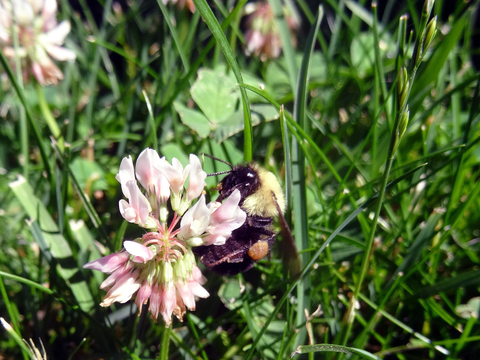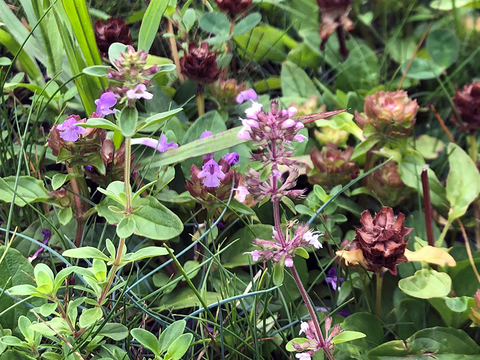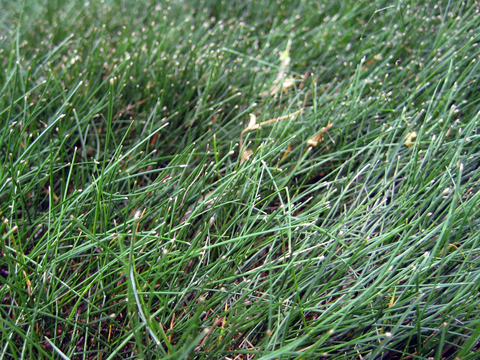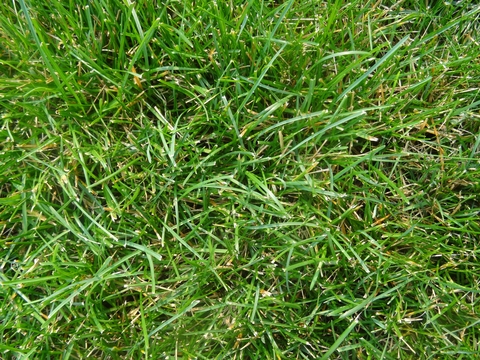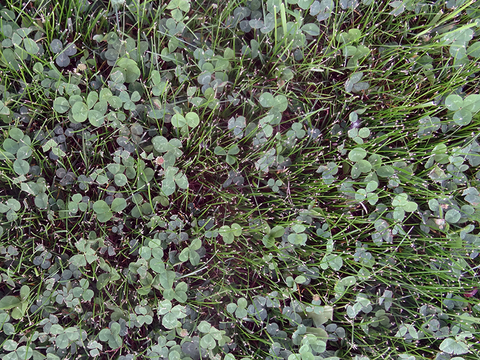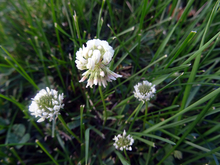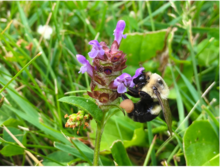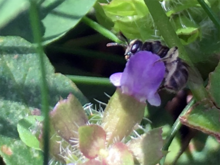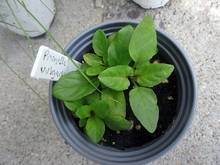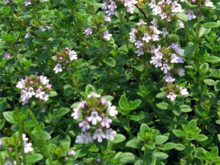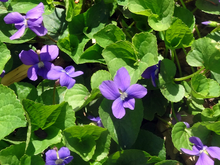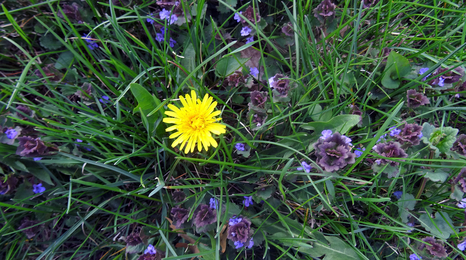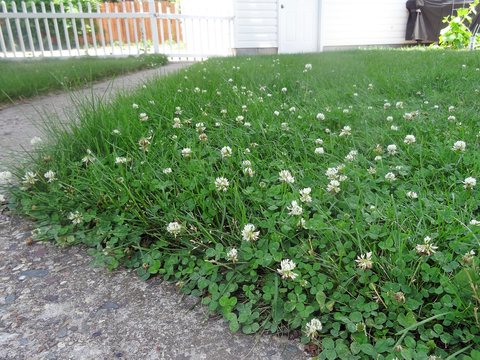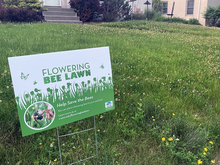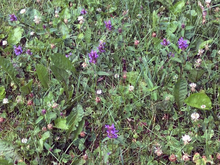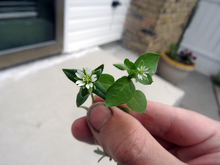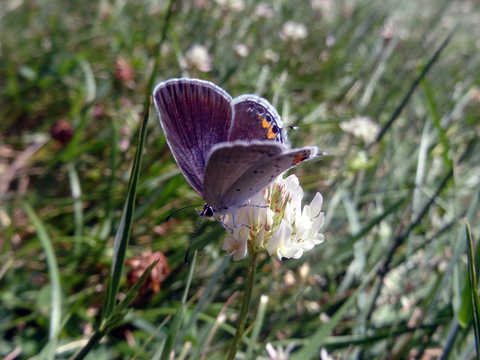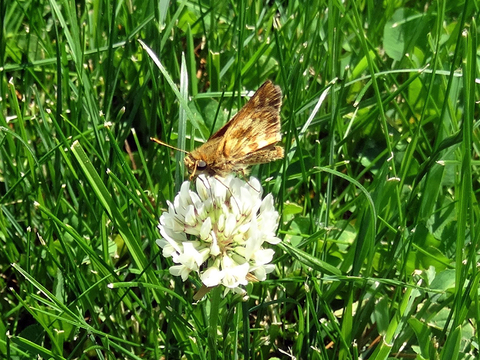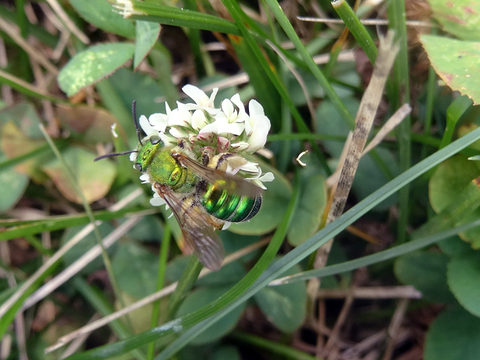Quick facts
- Bee lawns have flowers mixed in with turfgrasses such as fine fescues and Kentucky bluegrass.
- The flowers of a bee lawn provide food (nectar and pollen) for pollinators.
- Bee lawns are environmentally friendly because they are managed using low-input methods that generally use less fertilizer and pesticides.
- Bee lawns can still be used recreationally by your household like a regular lawn.
- A bee lawn can attract over 50 species of native bees.
Are you interested in doing more to help our native pollinators? You can make your lawn do double duty! A bee lawn can not only provide a recreational space for you, your family and your pets, it can also provide much-needed food resources for bees and other beneficial pollinators.
While turfgrasses can provide some environmental benefits, they don’t provide much food for pollinators.
One way to provide resources for pollinators while keeping the function of a lawn is to incorporate other plants such as dutch white clover, self-heal and creeping thyme. These plants have the right type of flowers for bees.
Once established, bee lawns take a similar (or even less) amount of work to maintain as a traditional lawn, making them an accessible addition to almost any home landscape.
Plants for a bee lawn
There are lots of plants that bees like, but few are adapted to lawn conditions. Not many plants besides turfgrass can tolerate being mowed short and stepped on. Here are the traits needed for bee lawn flowers:
- Low-growing and adapted to being mowed.
- Flower at low heights.
- Tolerant of foot traffic.
- Provide good food (nectar and pollen) for pollinators.
- Moderately competitive, meaning they can hold their own with the turfgrasses without taking over.
- Have a perennial life cycle (they live for more than one year) so they are maintained in the landscape with the perennial turf.
Turfgrasses for bee lawns also need certain characteristics that make them compatible with the flowers.
There are many options for cool-season turfgrasses to use in home lawns. Research by UMN researchers on bee lawns has found some that perform better in bee lawns in Minnesota.
Fine fescues are a group of five different species that include:
- Strong creeping red fescue
- Slender creeping red fescue
- Chewings fescue
- Hard fescue
- Sheep fescue
A mix of fine fescues is considered the best option for bee lawns because fine fescues do well with little to no inputs of fertilizer, irrigation, or pesticides for weed control. Plus they are compatible growing together with bee lawn flowers.
Kentucky bluegrass will also work well because of its growth habit and its tolerance of growing with many of the bee lawn flowers. But Kentucky bluegrass tends to need more fertilizer and water compared to the fine fescues.
Two other commonly used turfgrasses in our region are perennial ryegrass and tall fescue, but they are not recommended for bee lawns.
More about turfgrasses
University of Minnesota researchers have studied which flowers are most successful in bee lawns. Our list of bee lawn flowers includes dutch white clover, self-heal, and creeping thyme. These three will be the easiest to establish and easiest ones for which to find seed.
Dutch white clover
Dutch white clover (Trifolium repens), often just called white clover, was once commonly included in lawn seed mixes. It is a non-native species (as are all the cool-season turfgrasses) and somewhere along the line it became considered a weed. You have probably seen white clover many times and may already have white clover in your lawn.
It is unfortunate that white clover is now thought of as a weed in home lawns. White clover has many positive traits that make it ideal for a bee lawn. It is tolerant to some shade, though it may bloom sparsely without enough sun, and is adaptable to different soil types.
White clover has one particular trait that the other two bee lawn flowers don’t have. As a legume, it has the ability to fix its own nitrogen. This means that white clover doesn’t need to be fertilized with nitrogen, making it a good part of a low-input lawn.
White clover has a long bloom time, usually from the end of May to October with a peak of flowering in June.
The forage quality of the flowers for bees is excellent. Its pollen has the high protein content that pollinators that collect pollen need and the nectar has a high sugar content, which is good for those pollinators that depend on nectar.
The flowers can be fragrant and are reminiscent of honey. The flowers are white and sometimes have a pinkish tint.
White clover is often used by beekeepers as a forage crop for their honey bees in honey production. Learn more about the UMN’s work with honey bees.
Self-heal
Self-heal (Prunella vulgaris ssp. lanceolata) is another plant that has been found to work well in bee lawns. One thing different about this plant, as opposed to the other two common bee lawn flowers, is that this one is native to our region.
UMN researchers have found that self-heal, being a native plant, is especially good at attracting native bees. They found that 95% of the flower visitors to self-heal were native bees.
Self-heal is adaptable to many different home lawn conditions.
- It can grow in sun to part shade, and in different soil types except for sandy soil.
- The time of bloom is June to August.
- The purple flowers produce mostly nectar along with some pollen for pollinators.
For people who enjoy a pop of purple color in their bee lawns, self-heal flowers are a nice addition. One interesting thing about self-heal is its flowers attract some of the larger bees in Minnesota such as bumblebees, while also attracting very small bees that can fit directly inside the flowers to get nectar. Other insect pollinators include butterflies.
Creeping thyme
Creeping thyme (Thymus praecox ssp. arcticus; formerly Thymus serpyllum) is a close relative of culinary thymes such as French thyme or lemon thyme. Like its relatives, creeping thyme has foliage with a nice fragrance.
Thymes are known for being tolerant of some foot traffic and have a low-growing habit, traits that are good for bee lawns.
Creeping thyme is a non-native plant that blooms from July to September, a somewhat shorter period than white clover. It does best in full sun and in sandy or loamy soil. It has small pink flowers that provide pollinators with mostly nectar and some pollen.
Other flowers
Research at the University of Minnesota has found that white clover, self-heal and creeping thyme work the best in a bee lawn. Seed for these plants can be easily found, especially within pre-existing bee lawn mixes.
There are other less common options, including other native species, that could work, but they may be more of a challenge depending on your site. You might also consider these Minnesota native flowers:
- Ground Plum (Astragalus crassicarpus)
- Lanceleaf Tickseed (Coreopsis lanceolata)
- Calico American Aster (Symphyotrichum lateriflorum)
Existing flowers in your lawn
If you’re a person who doesn’t use herbicides, your lawn might already have some flowers of the weedy kind. You may already have a bee lawn! Some common weeds are actually helpful to pollinators.
Common violets (Viola sororia) are native lawn weeds that can have some benefits for pollinators. There are some fritillary butterflies whose larvae use these violets as a host plant and a few bees that forage on violet flowers.
Common violets do have some shade tolerance and, of course, seem to do well in lawns where they are often considered a weed. Be aware that the bloom season is short and violets can take over under the right conditions.
Dandelion is a non-native plant and its eye-catching yellow flowers have pollen that can attract a few pollinators. One good quality of dandelions is that they bloom early in the season when most other bee lawn flowers aren’t blooming. It is likely that if you have a bee lawn or a low-input lawn, there will be some dandelions unless you hand weed them out.
The weed that Minnesotans love to hate, creeping charlie is generally not recommended for a bee lawn. While it provides some nectar for bees, it is not a reliable food source. It is very invasive and can outcompete better quality bee lawn flowers such as white clover. Plus your neighbors may be unhappy if you are encouraging it to grow next to their yard.
You may be interested in
How to plant a bee lawn
There are a few things to consider when choosing where to put your bee lawn. It needs to work with how you use your yard and also be a place where the plants will grow well.
Most people with yards probably have several different spots for a bee lawn - backyards, front yards, boulevards, strips between houses, or other areas. Just because you commit to having a bee lawn doesn’t mean you need to convert your entire lawn immediately. It’s okay to start with one area at a time.
Consider how much your lawn is used. Lower traffic areas are good choices for a bee lawn to give pollinating insects space to forage. For instance, the backyard may be used by your family more frequently than the front yard, so perhaps the front yard with its lower traffic might be better for your new bee lawn.
If you have a sloped area, that could be a good option. Your household probably isn’t using the space often. Plus, whoever mows the lawn may appreciate mowing that part of the yard less frequently. Bee lawns are designed to be low input and don’t need as much mowing.
Take your neighbors into consideration. Ones who are fussier about their lawns may not appreciate your new bee lawn flowers creeping into their lawn. Maybe in this case your backyard would be better. You can also choose a site that is bordered by sidewalks or edging. This will help creeping plants like white clover and creeping thyme stay in their place.
Bee lawn signs can go a long way in neighborhood acceptance. Templates for printing your own signs can be found on the Bee Lab website.
Sites with light to moderate traffic work nicely for bee lawns.
- Heavily trafficked soils can become compacted, making it difficult for many plants to grow.
- If grass doesn’t grow there, the combination of grass and bee lawn flowers will probably not either, unless you can fix the compaction and control the heavy traffic.
Bee lawns will need sun to part-sun conditions. Pollinators tend to be creatures of the sun after all!
- Bee lawns will not thrive in deep shade (sites without any direct sun).
- Not enough sun will lead to thin turf and few or no flowers.
Sites that are already extremely weedy will be a challenge for establishing a bee lawn. If there are too many weeds, they will outcompete the bee lawn flowers.
Bee lawns are adaptable as far as soil types are concerned.
- Whether sandy, silty, loamy or clay, at least one of the common bee lawn flower options should grow in sites where turfgrass is able to grow.
- The species in a bee lawn grow best in soils that are slightly acidic to neutral (pH of 6.0 - 7.0).
- White clover can be tolerant down to a pH of 5.5.
Don’t know your soil type or pH? A soil test from the UMN Soil Testing Laboratory can provide you with that information.
Bee lawn flower sun and soil conditions
| Plant | Full sun | Part sun to shade | Sandy soil | Silty/Clay/Loam soil |
|---|---|---|---|---|
| Dutch white clover | x | x | x | x |
| Creeping thyme | x | x | x | |
| Self-heal | x | x |
The popularity of bee lawns has led to the availability of pre-mixed seed blends that contain the proper ratio of fine fescues along with white clover, self-heal and creeping thyme. As a general rule, per 1,000 square feet, we recommend a seeding rate of:
- Fine fescue - 4 lbs
- Dutch white clover - 1.1 oz
- Creeping thyme - 0.16 oz
- Self-heal - 1.2 oz
Pre-mixed bee lawn seed bought off the shelf usually has a recommended rate of 5 pounds of seed per 1,000 square feet and should have a similar proportion of species as the list above. Note that actual seeding rates can vary depending on the density of plants already present in your lawn and the planting method used.
If you want to customize your own mix by buying each species separately and mixing your own blend (such as to include or exclude a certain species), make sure to buy Minnesota-adapted cultivars. For example, there are white clover varieties for southern states that will not do well in the Midwest.
What about sod?
At this time, bee lawn sod is not commercially available. If you are interested in speeding up the development of your bee lawn, you can plant already growing bee lawn plants into an established healthy lawn.
Particularly for creeping thyme, which is trickier to get established from seed, sometimes small seedlings (called “plugs”) are used as another option for planting. Plugs can be hard to find, and this might only be an option for small sites due to the greater cost of plugs compared to seed.
The UMN Turfgrass Science team has put together a list that is updated regularly of where to find bee lawn seed.
Bonus tip: Do you already have white clover in your lawn? Reducing fertilizer and herbicide use will make it become more prevalent on its own and then you can focus on adding self-heal and creeping thyme seed.
Establishing a bee lawn
Once you have a good idea of which plants you want in your bee lawn, the next step is to decide when to establish it and which establishment method to use. Based on the experiences of UMN researchers, the best times to establish are spring or late fall, and the methods are either overseeding or renovation.
Installing and maintaining a bee lawn provides a good overview of this process.
The best time to seed a bee lawn (and a good time to seed lawns, in general) is in the late fall. This is called dormant seeding, which means planting after the growing season is done.
In this technique, the seed is spread after the soil is too cold for germination, usually in early November to mid December for Minnesota.
- If the seed has the soil-to-seed contact it needs, the freeze-thaw cycle over the winter will work the seed into the soil.
- It is less work than a spring seeding because you will not need to water or fertilize.
- The seed will germinate early in the following spring and have a head start over spring weeds.
Spring seeding is the second-best option.
- For a spring-seeded bee lawn in Minnesota, seed is planted after the risk of frost is over from mid-May to early June.
- This time can work well, but there will be more challenges with weeds.
- Unlike dormant seeding, the site will need to be watered regularly after planting.
Either of these times can work with how you choose to establish as described in the next section. You may wonder if fall is a good time to plant a bee lawn (as it is recommended for a regular lawn). However, fall is not the best planting time for the flowers of a bee lawn.
There are two good ways to convert your lawn into a bee lawn: overseeding or renovation.
How do you determine which one is for you? Base your decision on the existing species in your lawn and the health of your lawn. Basically, you are making a choice to work with what you already have or to start over from scratch.
- If your lawn is healthy and has relatively few weeds, overseeding is better.
- If your lawn is mostly “bad” weeds that aren’t good for pollinators and it has more than a few bare spots, renovation is better.
- If you have areas you would like to correct because of unevenness, compaction, or grading to correct a slope, renovation is better.
- Still not sure? Overseeding is less work so that might affect your decision.
Overseed or renovate?
| Why to overseed | Why to renovate |
|---|---|
| Lawn is healthy with few weeds. | Lawn is mostly “bad” weeds that aren’t good for pollinators. |
| It's less work. | Lawn has many bare spots. |
| Lawn needs correction for unevenness, compaction or grading. |
The goal for overseeding is to set back the existing turf temporarily to give space to allow the new bee lawn seed you will be adding a chance to grow. Over time, that existing turf bounces back and grows again.
The first step for this technique is to mow the lawn very short to about one inch in height. The goal is to have some soil exposed as that is where the new seed will grow.
You can also aerate to help establishment in compacted soil even more. For extremely thick lawns, a power rake may be necessary to expose the soil. You can rent both aeration and power rake equipment or a lawn service company can do these steps for you. Depending on your lawn conditions, you may not need these additional steps.
UMN Extension has an older video with detailed instructions on overseeding white clover into existing turf. The steps are the same for a bee lawn. The how-to part begins after the 9:00-minute time point. Note that seeding rate recommendations have been updated from the time this video was produced.
The next step is to rake the excess vegetation, leaving the soil. The site is ready for seed, whether you are planning to plant in spring or dormant seed.
In this method, all the existing plants of a lawn are removed (killed). There are several ways to kill the existing turf:
Solarization
- This technique can only be done during warm weather.
- It involves spreading out clear or transparent plastic over the area, pinning it down and leaving it on for a month.
- The heat builds up under the plastic and over time kills the plants beneath.
- Drawbacks to this method are that it takes a while and can only be done during a limited period when it’s warm enough.
- July and August are the best times for solarization in Minnesota.
Physical removal
- Special equipment can be rented to physically take off the existing lawn.
- You can use a sod cutter (a gas-powered machine that cuts the grass off at the roots), or a sod kicker (the manual version of a sod cutter) to remove the lawn vegetation.
- This process is not dependent on having very warm temperatures so it can be done at any time of the growing season.
- Drawbacks are that you have to find something to do with the sod that has been removed and taking the top layer of your soil off is removing beneficial organic matter from your soil.
Herbicides
- Generally, the goal of a bee lawn is to use less pesticide, but some people may choose to use herbicides because they quickly and easily remove existing vegetation.
- For tips on using herbicides as part of the renovation process, watch this video.
- Herbicides do have specific temperatures where they are most effective, usually between 65 to 85 degrees.
The Xerces Society has a guide to pollinator habitat site preparation for information on other techniques.
Once the plants are dead or have been otherwise removed, an additional step that will help in establishing is aeration. This is also the perfect time to level out the soil if it is uneven. Before planting, your soil should be raked to remove any excess debris.
Seedbed preparation is covered in detail in this video.
After these steps, the site is ready for seed, whether you are planning to plant in spring or dormant seed.
Whether overseeding or renovating, the process of seeding is similar. There are a few differences between dormant and spring seeding.
For both dormant and spring seeding times, spread seed using the proper equipment such as a drop seeder at the correct rate. This video, Home Lawn Conversion Part V Seeding, discusses seeding fine fescues, and many of the techniques apply to seeding bee lawns.
When using a bee lawn seed mixture, the recommended rate is usually around 4-5 pounds of seed per 1,000 square feet. For small spaces, it is okay to spread seed evenly by hand as long as you know the correct amount for the size of your site.
An additional option when using the spread-by-hand technique, as shown in the Creating a bee-friendly lawn video, is mixing the seed with sand to help distribute the small seeds more easily.
Lightly rake seed into the soil. The majority of the seed should be lightly covered. If a soil test shows a nutrient deficiency, you may benefit from using a starter fertilizer for spring establishment (this will be labeled as such at your garden center or hardware store).
Keep off of the area (keep pets away, too) just as you would for any new lawn planting. Seeding blankets (also called germination or erosion blankets) can be placed on the site. They are particularly recommended for sloped sites, but they also help people remember not to step there. Watch Home Lawn Conversion Part VII Erosion Control for more on seeding blankets.
Again, just for spring establishment, lightly water 2 to 3 times per day for a few weeks to keep the ground consistently moist. Once you see new seedlings, you can gradually cut back on watering.
With dormant seeding, after you have spread the seed, there is no need to rake the seed in, use starter fertilizer, or water. Winter does all the work.
Does the whole process of overseeding or renovation followed by seeding sound too daunting? Or maybe you are short on time. The good news is that in response to the increasing demand for bee lawns, there are sustainable and organic landscape contractors that can do the installation for you. Check out the Purchasing bee lawn seed webpage for more information.
After seeding
You may wonder after you are finished if your planting is a success. Realize that your bee lawn may take some time to establish.
In the first year, you should see mostly turfgrass with some foliage from the flower plants and maybe a few white clover flowers. But by the second year, there should be even more white clover flowers, along with self-heal and creeping thyme flowers. Then the bees and other pollinators should follow.
Don’t forget to add a yard sign letting people know about your bee lawn. Signs that you can print yourself are available from the UMN Bee Lab.
Maintaining a bee lawn
Now that your bee lawn is planted and growing, you will need to care for it moving forward. If you have already been maintaining a lawn, it really isn’t much different. Potentially your bee lawn will become less work, but with more insect wildlife enjoyment.
Watering is absolutely needed when establishing in spring, but after that first season, very little supplemental irrigation should be needed.
The fine fescues found in bee lawn mixes can stay green with less water as compared to a higher-input lawn consisting of Kentucky bluegrass.
Only in times of prolonged drought will watering be necessary, assuming there are no watering restrictions in place.
For more on watering your lawn, read Water-saving strategies for home lawns.
Once the newly seeded bee lawn is 5 or 6 inches, you can mow for the first time. Be sure to only mow the top one-third of the lawn height.
Mowing an established bee lawn is similar to mowing a regular lawn, with the following exceptions:
- Mowing should be done at a higher height, so adjust your mower to at least 3 inches or more.
- Mowing should be done less frequently in general, about every 2 to 3 weeks depending on the time of the year.
- Hold off on mowing when bee lawn flowers are in full bloom to allow pollinators time to forage.
- Recycle lawn clippings instead of bagging and removing them; this adds nutrients back to your soil.
Mowing does have some benefits in reducing weed pressure and can help encourage further blooming of the flowers. Recycling clippings may also help sustain the bee lawn flowers by spreading any seed that has developed.
See Mowing practices for healthy lawns for more on mowing your lawn.
One thing to remember about bee lawns is if you fertilize too much, not only is it potentially unfriendly to the environment, it is favoring turfgrass over your bee lawn plants. That means more grass and fewer flowers for pollinators.
In most cases, established bee lawns should need little to no supplemental fertilizer. Not more than one light application of lawn fertilizer in the fall, if that, should be enough to keep your bee lawn healthy. This would be similar to the application rate of a low-maintenance regular lawn.
See Fertilizing lawns for more information on when and how much to fertilize.
Weeding is critical when your bee lawn is getting established. If you can keep unwanted weeds out until the plants you want to grow come in, the weed pressure should decrease over time. A healthy bee lawn is the best defense against weeds.
To manage weeds during the growing-in phase, pull weeds by hand. Hand weeding is recommended over the long-term, too, whenever possible. Also, it doesn’t hurt to learn to tolerate a few weeds that are beneficial to pollinators.
Herbicides
Many herbicides designed for regular lawns have the potential to kill your bee lawn flowers. If using weed-and-feed products, be aware of which active ingredients they contain. Some contain crabgrass pre-emergent herbicides, which can be a safer option as far as non-grasses are concerned, while others have ingredients called broadleaf herbicides that are designed to harm non-grasses such as your bee lawn flowers. If you must use herbicides:
- Avoid using them in times when pollinators are present and flowers are in bloom.
- Try spot treating (always a good policy, even with a regular lawn) instead of broadcast treatments.
- Make sure you are using the correct product to address your weed problem.
Common weeds confused with bee lawn species
If you are not a plant person, figuring out what is a weed and what is a bee lawn flower seedling is admittedly difficult when there are no distinctive flowers. There are some look-alike weeds to watch for.
Clover-like weeds
Without flowers, white clover can be confused for yellow woodsorrel, black medic, and birdsfoot trefoil. All three of these weed species have similar leaves to clover. White clover leaves often have what is called a "watermark," which are white markings on the leaves. But sometimes white clover leaves don’t have watermarks so that is not necessarily a distinguishing feature. There are other differences in the leaves (click on images to expand).
Self-heal compared to dandelion
Self-heal when young can be confused with dandelions or young broadleaf plantains. One identifying feature of self-heal is its square stem.
Creeping thyme
Young creeping thyme before it is flowering can be confused for mouse-ear chickweed, common chickweed, prostrate spurge and prostrate knotweed. Creeping thyme, unlike these weeds, has a square stem.
Check out Is this plant a weed? from UMN Extension for more on identifying weeds in the home landscape.
Common failures to watch for during establishing bee lawns:
- Planting at the wrong time.
- We recommend dormant or spring seeding. That means summer and fall are NOT good times.
- Not providing enough water during establishment.
- Make sure you water properly if you plant in the spring.
- The site is not suitable for a bee lawn.
- Deep shade or heavily compacted areas are not good locations.
Some problems that may occur later:
- All grass, no flowers. There could be many reasons for this result.
- It could be too soon in the establishment for the flowers to be blooming. Remember that of the three flower species, only white clover is likely to bloom the first year.
- The second year, as long as they were established in the first place, you should see some of the other two flowers.
- If it is past the second year without flowers, you may have to overseed again.
- Too many weeds.
- The bee lawn mix might not have established well or weeds were not controlled well at planting.
- Consider starting over with a renovation.
- Bee lawn flower plants disappear over time.
- This could be due to over-fertilizing.
- Or depending on management and site conditions, your bee lawn flowers just may not persist over the long term.
- Additional overseeding with more bee lawn seed in following years is always an option to keep flower density at the level you prefer.
Observing your bee lawn pollinators
Did you know that Minnesota has over 400 species of bees? UMN research found 56 bee species on just white clover. And that’s only one type of pollinator! Other important pollinators include butterflies, moths, flies, beetles and wasps.
You may wonder about attracting all these bees to your yard — will having a bee lawn mean greater chances of getting stung? Most native bees are docile and unlikely to sting. Some stinging insects such as non-native yellowjacket wasps can be aggressive though! Learn more about wasps and whether they pose a hazard in your yard and should be removed. Most wasps are beneficial so try to let them be when possible.
We encourage you to learn more about the native pollinators that visit your bee lawn. If you look more closely there is a whole new world happening at your feet!
Visit the University of Minnesota Bee Lab website for more information on honey bees, native bees and how you can become more involved in helping bees and other pollinators.
Helping pollinators - the next steps
Bee lawns are a great addition to urban and suburban landscapes, but they aren’t as valuable to pollinators as plantings with a full complement of native perennials, trees and shrubs. You can think of bee lawns as a nice enhancement to your other garden plants for pollinators.
To learn more about other plantings for pollinators:
Interested in helping researchers who study pollinators? There are many community science projects that you can be involved with. You can even collect bee data from your own backyard!
- Bee Lawn. UMN Bee Lab
- Lane, Ian. Bee Lawns. Video (06:25). March 20, 2015.
- Lane, Ian, Eric Watkins, and Marla Spivak. Turfgrass Species Affect the Establishment and Bloom of Kura Clover (Trifolium ambiguum) in Lawns. HortScience horts 54, 5 (2019): 824-828
- Meyer, Mary H. Bee Lawns and Pollinator Gardens: Creation, Design, Plant Choice and Sustainability. 2014.
- Meyer, Mary H. and Michelle Wisdom. Help Pollinators by Planting a Bee-Friendly Lawn. 2020.
- Meyer, Mary H. Smart Garden 2020: How to plan a Bee Lawn. Yard and Garden News. April 1, 2020.
- Planting for Pollinators: Principles and Design for Residential Pollinator Habitat. Minnesota Board of Water and Soil Resources - Lawns to Legume program. 2020.
- Ramer, H., J. Wolfin, K. C. Nelson, M. Spivak, E. Watkins and M. Pulscher. Flowering Bee Lawns: A Toolkit for Land Managers. PDF. 2019.
- SARE. White Clover in Managing Cover Crops Profitably. 2007
- Wolfin, James. Floral Enhancement of Turfgrass Lawns for the Benefit of Bee Pollinators in Minneapolis, Minnesota. 2020.
- Wolfin, James. If you build it, who will come? Evaluating the diversity of bees in flowering lawns. Turfgrass Science. Feb. 3, 2019.
- Wolfin, James. Weeds in the Turf Lawn: Invasive Nuisances or Sources for Forage? Turfgrass Science. Nov. 17, 2016.
- Turn Your Lawn Into A Pollinator Haven. An interview with James Wolfin. The Maverick FM. April 23, 2021.
- The Xerces Society. Plants for Pollinators: Violets. April 2017.
Reviewed in 2023


